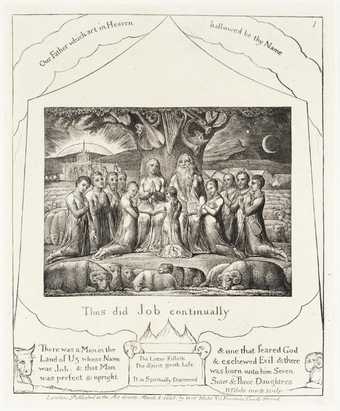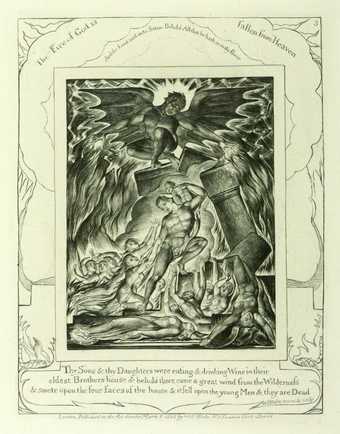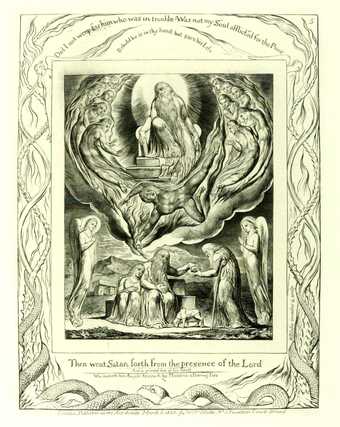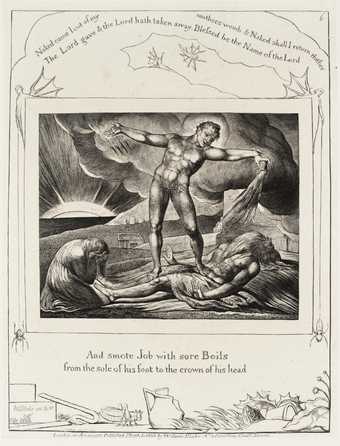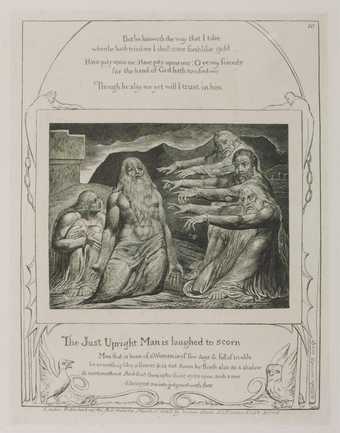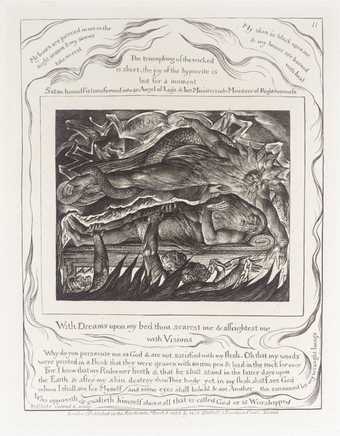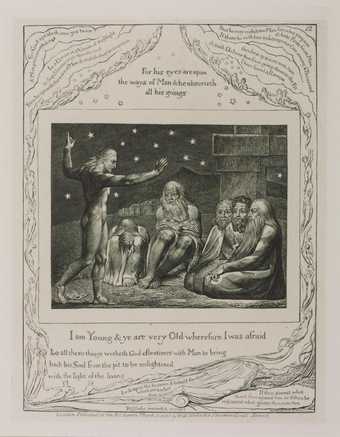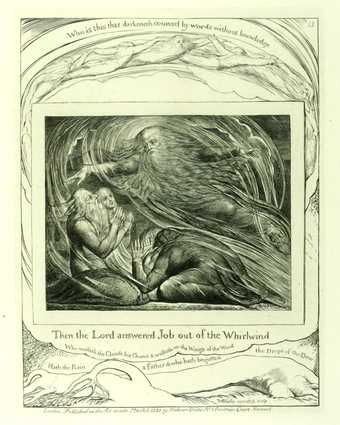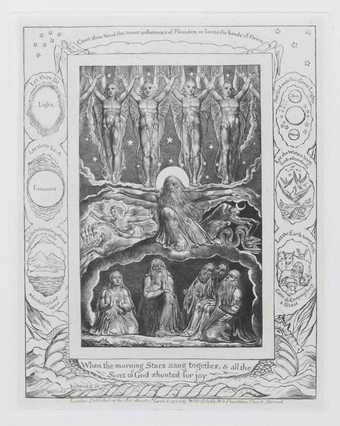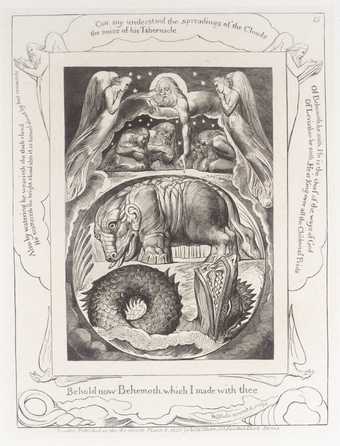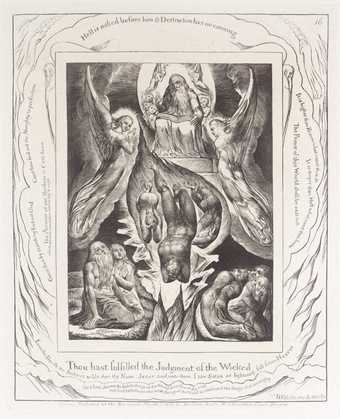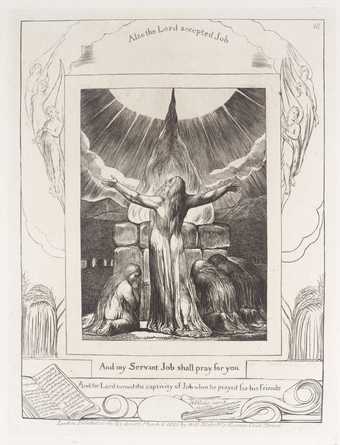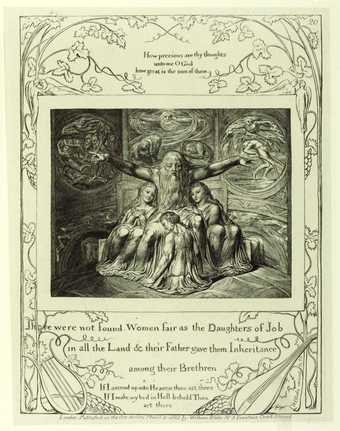
In Tate Britain
Prints and Drawings Room
View by appointment- Artist
- William Blake 1757–1827
- Medium
- Line engraving on paper
- Dimensions
- Image: 200 × 151 mm
- Collection
- Tate
- Acquisition
- Purchased with the assistance of a special grant from the National Gallery and donations from the Art Fund, Lord Duveen and others, and presented through the Art Fund 1919
- Reference
- A00028
Catalogue entry
A00028 [from] Illustrations to The Book of Job: Engravings
1823–6/1874 [A00012-A00032; T05845; complete]
A 00012–32 /-
Twenty-two line engravings on india paper laid on drawing paper approx. 510×345 (20×13 1/2)
Purchased with the assistance of a special grant from the National Gallery and donations from the National Art-Collections Fund, Lord Duveen and others, and presented through the National Art-Collections Fund 1919
PROVENANCE John Linnell; his heirs, sold Christie's 15 March 1918 (183) £33.12.0.bt Martin for the donors
LITERATURE Gilchrist 1863, 1, pp.283–4, 297; Wicksteed 1910 and 1924; Russell Engravings 1912, 102–15 no.33: Keynes Bibliography 1921, pp.179–82 no.55: Binyon and Keynes 1935, series repr. vol.VI; Keynes Engravings 1950, pp.16–17, series repr.pls. 42–68; Keynes Writings 1957, pp.869–70, 872, 874, 876–7; S. Foster Damon, Blake's Job 1966, series repr.; Bentley Blake Records 1969, pp.234 n.i, 277–397 passim, 586–605; Andrew Wright Blake's Job: A Commentary 1972, series repr.; Lindberg 1973, pp.24–32, 40–52, 167–76, 183–352 nos.0A–21A, series repr.; Bentley Blake Books 1977, pp.517–24 no.421; Bindman Graphic Works 1978, pp.486–7 nos.625–46, series repr.; Mitchell 1978, pp.41–2; Essick Printmaker 1981, pp.92, 105, 220, 234–50, 252; Robert N. Essick, ‘Blake's Engravings to the Book of Job; An Essay on their Graphic Form with a Catalogue of their States and Printings’ in David Bindman, ed., William Blake's Illustrations of the Book of Job 1987, pp.35–101.
John Linnell, who had commissioned the second set of watercolour illustrations to the Book of Job in 1821, entered into a formal agreement with Blake for the engravings on 25 March 1823: Linnell was to pay Blake £5 a plate or £100 for the set, and in addition he agreed to give Blake an extra £100 if the profits of the work made this possible. The agreement was for twenty engravings though in the event twenty-one subjects were engraved together with a title-page. On 5 March 1825 Linnell went with Blake to the printer J. Lahee to see proofs being taken. The series is dated 8 March 1825 but the final engravings do not seem actually to have been ready until the end of March 1826 (Bentley 1969, pp.277, 300 and 327). At this time 215 sets of engravings marked ‘Proof’ were issued; these should be distinguished from the working proofs, on some of which Blake tried out designs for the borders. The word ‘Proof’ was then deleted (traces can be seen on A00013) and a further 100 sets were printed on drawing paper. According to John Linnell Jr, writing to Bernard Quaritch on 6 May 1892, Linnell, after the 1826 printing, ‘put the plates away, & they were never again used after this time until the year 1874. At this time my father...had one hundred copies printed from the plates upon India paper’. Although the distinctive cover is now missing, it seems that the Tate Gallery's copies of the engravings are from this 1874 printing. The original plates were given by Herbert Linnell to the British Museum Print Room on 28 May 1919.
Each engraving is inscribed ‘W Blake inv. & sculp’. In addition each is inscribed in the lower margin with variations of the text ‘London. Published as the Act directs March 8:1825 by William Blake No3 Fountain Court Strand’; the first actual design (A00012) is mistakenly dated with the year 1828 and ‘Willm’ is sometimes substituted for ‘William’, while the punctuation is also slightly varied.
More importantly, the borders of each design bear a number of inscriptions taken from the Bible or with variations of biblical texts. These add a verbal gloss to the designs which in themselves embody Blake's critical reaction to the original story as set out in the Old Testament. The fullest analysis is in Lindberg though Wicksteed, Damon 1966 and Wright also contain full commentaries. Blake's interpretation of his text is only given in summary form in this catalogue.
These engravings were formerly inventoried as nos.3372 i–xxii. The new inventory numbers omit the title-page.
A00028 The Vision of Christ
Line engraving 200×151 (7 7/8×5 15/16); platemark 219×170(8 5/8×6 11/16)
Inscribed ‘WBlake’ b.l. and ‘inv & sculp’ b.r., ‘London Published as the Act directs March 8: 1825 by William Blake No3 Fountain Court Strand’ below, ‘17’ t.r., and with texts given below
Illustration no.17: Job, xlii, 5, the source of Blake's main title which significantly omits the word ‘of’ from the Authorised Version, following the Vulgate: ‘I have heard [of] thee with the hearing of the Ear but now my Eye seeth thee’. Another of the lines quoted by Blake had already been used by St Gregory the Great as an interpretation of Job's revelation as being his apprehension of the unity of Christ and the Father: ‘I & my Father are One’ (John, x, 30), and this is accompanied by another quotation of similar import, ‘He that hath seen me hath seen my Father also’ (John, xiv, 9). The theme is developed in a selection of further sayings from John, xiv, partly rearranged but forming a coherent whole: ‘If you had known/me ye would/have known my/Father also and/from henceforth/ye know him &/have seen him/Believe me that/I am in the Father & the Father in me/He that loveth me/ shall be loved of/my Father/For he dwelleth in/you & shall be with/you’, ‘At that day ye shall know that I am in/my Father & you in me & I in you/If ye loved me ye would rejoice/because I said I go unto the Father’, ‘He that loveth/me shall be loved/of my Father & I/will love him &/manifest myself/unto him/And my Father/ will love him & we/will come unto him/& make our abode/with him/And the Father/shall give you/Another Comforter/that he may abide/with you for ever/ Even the Spirit of/Truth whom the/World Cannot receive’ (John, xiv, 7, 11, 16–17, 20, 21, 23, and 28): Further quotations continue this theme and the identification of Job's judgment with that of mankind as a whole: ‘He bringeth down to/the Grave & bringeth up’ (I Samuel, ii, 6); ‘we know that when he shall appear we shall be like him for we shall see him as He Is’ (John, iii, 2); ‘When I behold the Heavens the work of thy hands the Moon & Stars which thou hast ordained. Then I say. What is Man that thou art mindful of him?/& the Son of Man that thou visitest him’ (Psalms, viii, 3–4).
Blake stresses the difference between Job's finite world and the infinite world of his vision by placing God on a cloud rather than on the earth; however, the flames of inspiration spread beyond God to embrace the kneeling figures of Job and his wife though they only just touch the three friends. In the lower margin an angel is shown with a quill, accompanying the open books and scroll bearing the quotations from St John. Wicksteed identifies her as Jerusalem but Lindberg doubts this; as she is definitely female she cannot be St John herself but is presumably his muse.
Published in:
Martin Butlin, William Blake 1757-1827, Tate Gallery Collections, V, London 1990
Explore
- objects(23,571)
-
- reading, writing, printed matter(5,159)
-
- book, ‘Bible’(19)
- scroll(24)
- actions: expressive(2,622)
-
- recoiling(65)
- arm / arms raised(839)
- crouching(276)
- head in hand / hands(278)
- kneeling(502)
- standing(3,106)
- man(10,453)
- beard(206)
- Bible: New Testament(545)
- 1 Samuel, chapter 2(1)
- Job(24)
- Job’s wife(13)
- Job, chapter 42(5)
- Psalms, 8(1)
- God(152)
- inscriptions(6,664)
-
- caption(358)
- printed text(1,138)
- quotation(297)
You might like
-
William Blake Job and his Family
1828, reprinted 1874 -
William Blake Satan before the Throne of God
1825, reprinted 1874 -
William Blake Job’s Sons and Daughters Overwhelmed by Satan
1825, reprinted 1874 -
William Blake Satan Going Forth from the Presence of the Lord, and Job’s Charity
1825, reprinted 1874 -
William Blake Satan Smiting Job with Sore Boils
1825, reprinted 1874 -
William Blake The Vision of Eliphaz
1825, reprinted 1874 -
William Blake Job Rebuked by his Friends
1825, reprinted 1874 -
William Blake Job’s Evil Dreams
1825, reprinted 1874 -
William Blake The Wrath of Elihu
1825, reprinted 1874 -
William Blake The Lord Answering Job out of the Whirlwind
1825, reprinted 1874 -
William Blake When the Morning Stars Sang Together
1825, reprinted 1874 -
William Blake Behemoth and Leviathan
1825, reprinted 1874 -
William Blake The Fall of Satan
1825, reprinted 1874 -
William Blake Job’s Sacrifice
1825, reprinted 1874 -
William Blake Job and his Daughters
1825, reprinted 1874

